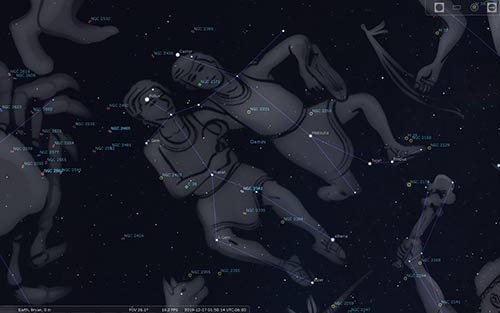Page 8


EYE ON THE SKY - GEMINI
By Tom Campbell
In Greek mythology, Castor and Pollux were half-brother identical twins. Castor had a mortal father while Zeus was the father of Pollux. They also had a famous sister: Helen of Troy.
Both twins grew up to become warrior heroes and were members of Jason's crew. When they first boarded the Argo, it is said that two flames leapt up from the mast. This flame can still be seen sometimes today and is known as St. Elmo's fire.
The constellation of Gemini depicts these two brothers. The brightest two stars are the brothers' heads and are given their names.
Castor (α Gem) is the second-brightest star in the constellation and actually is part of a six-star system. There are three components that can be seen through a telescope and each of these components has a spectroscopic companion. Castor A and Castor B are bright blue-white stars having an angular separation of about 6 arcseconds currently and can be separated at moderate magnification through a telescope. Castor C is a pair of dim red dwarfs 73 arcseconds away which orbits the AB stars once every several thousand years.
Wasat (δ Gem) is a triple star. The second component is faint and very close to the subgiant primary, so it is only seen spectroscopically. The third component, however, is an orange dwarf and can be easily seen at modest magnification. In 1930, Clyde Tombaugh discovered Pluto about half a degree east of Wasat.
Messier 35 is a large open cluster, taking about the same amount of sky as the Moon. It is sometimes called the Shoe Buckle Cluster due to it being located near the foot of Castor. Through the telescope, arcs of stars trail off in various directions and near the edge of the cluster sit a pair of bright stars, one of them blue and the other yellow.
NGC 2129 is a young star cluster located within our Local spiral arm of the Milky Way. The two brightest members are blue giants and believed to be a binary star system within the cluster. Through my 8-inch telescope, the cluster seemed sparser near the center and the stars formed the rough image of a letter D.
NGC 2158 is located very close to Messier 35, but it is much smaller and fainter. In my 8-inch telescope, it appeared as a hazy smudge with only a handful of stars resolved.
NGC 2266 is a fairly small but dense open cluster discovered in 1785 by William Herschel. In my 12-inch Dob, the cluster appeared triangle-shaped, with one edge consisting of an arc of the brightest stars. A couple dozen stars were visible with direct vision, but averted vision hinted at many more.
NGC 2304 was discovered on December 30, 1783 by William Herschel. He numbered it 85 in his personal catalog and described it as “a very compressed cluster of extremely small stars, irregular form, 5 or 6 arcminutes in diameter.” Through my 12-inch reflector at moderate powers, I was able to make out a small triangular grouping of stars and even using averted vision, I could only make out about 20 of its members.
NGC 2355 is estimated to be a billion years old and is located about 1100 light years above the plane of the Milky Way. In my telescope, the cluster appeared small and compact with mostly dim stars. It has a somewhat triangular shape.
NGC 2371/2372 (Peanut Nebula) is a dual-lobed planetary nebula. Each lobe is given a separate NGC number, but both are actually part of the same object. Visually, it is very faint and appears very elongated, with two almost stellar cores.
The Eskimo Nebula (NGC 2392) is a planetary nebula that is visible in small telescopes, but requires decent aperture in order to glean any detail.
NGC 2420 is a small open cluster in the general vicinity of the Eskimo Nebula. Through my 8-inch Dob, it appears as a dim smudge with a sprinkling of stars.
| Object | Type | Mag(s) | Dist. (ly) | R. A. | Dec. |
|---|---|---|---|---|---|
| Castor (α Gem) | Multiple Star | 1.9, 3.0 | 51 | 07h 34.6m | +31° 53' |
| Wasat (δ Gem) | Triple Star | 3.5, 8.2 | 60 | 07h 20.1m | +21° 59' |
| Messier 35 | Open Cluster | 5.1 | 3,870 | 06h 08.9m | +24° 20' |
| NGC 2129 | Open Cluster | 6.7 | 7,200 | 06h 01.1m | +23° 10' |
| NGC 2158 | Open Cluster | 8.6 | 11,000 | 06h 07.4m | +24° 06' |
| NGC 2266 | Open Cluster | 9.5 | 11,000 | 06h 43.3m | +26° 59' |
| NGC 2304 | Open Cluster | 10.0 | 14,300 | 06h 55.0m | +17° 59' |
| NGC 2355 | Open Cluster | 9.7 | 5,380 | 07h 17.0m | +13° 47' |
| NGC 2371-2 | Planetary Nebula | 13.0 | 4,400 | 07h 25.6m | +29° 29' |
| NGC 2392 | Planetary Nebula | 10.1 | 6,520 | 07h 29.2m | +20° 55' |
| NGC 2420 | Open Cluster | 8.3 | 8,100 | 07h 38.0m | +21° 34' |
